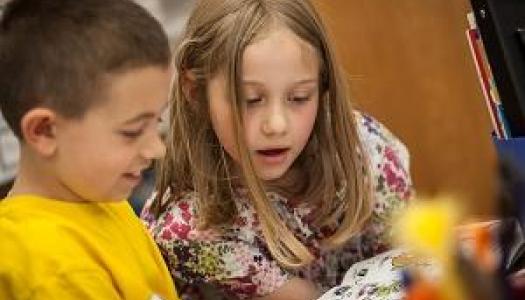Launching Daily 5 in Kindergarten, Part 8
Join Our Community
Access this resource now. Get up to three resources every month for free.
Choose from thousands of articles, lessons, guides, videos, and printables.

Introducing Listen to Reading in kindergarten is fun because the children genuinely love to listen to stories, and the technology piece enhances that even more. Before introducing Listen to Reading, a teacher will want to teach the foundation lessons that will prepare students for success. These foundation lessons include how to set up and clean up the technology, how to listen and follow along with the story, and what to do when a story is finished (listen again or find a new story).
Listen to Reading is introduced very similarly to Word Work. Because Read to Self and Work on Writing stamina is already established, and because we do not typically have enough materials for the entire class to practice at the same time, we do not build stamina as a group. Instead, we follow Steps 1–5 of the 10 Steps to Independence, and we offer it as a choice for a limited number of students.
The introduction of Listen to Reading in kindergarten resembles this:
Step 1: Identify what is to be taught: In a whole-group setting, the teacher tells the class, "You have worked so hard at being independent and building your stamina in Read to Self and Work on Writing, that today we are going to learn another piece of Daily 5: Listen to Reading!" The teacher writes a big I on chart paper and then writes "Listen to Reading" at the top. The teacher reminds the children that the I stands for "Independence" and reviews what it means. Then the teacher says, "Boys and girls, today we are going to learn how to listen to reading independently."
Step 2: Set a purpose and create a sense of urgency: To keep this lesson brief and focused, we provide the purpose, saying, "We listen to reading because it helps us become better readers and because it is fun!" The teacher writes these at the top of the I-chart. "It helps us become more fluent and expressive, and it helps us learn new words"
Step 3: Record desired behaviors on an I-chart: The teacher records the desirable behaviors on the I-chart and briefly explains each one. With younger students, we list and explain only the first two behaviors in the first lesson.
A student who is listening to reading, is paying attention while someone else reads a story. We listen to the expression in the reader's voice to help us understand what we are reading and hearing. Think about what it looks like when a person is listening to reading. Many of the behaviors are similar to the behaviors we learned about in the other components of Daily 5. The first behavior you will see is that a student listening to reading listens the whole time." The teacher writes, "Work the whole time" on the I-chart. "This means that you would be listening to stories the entire time. Another thing you would see is everyone staying in one spot." The teacher writes, "Stay in one spot." "This means that once you sit down, you would not get up and move around, but you would stay in that spot the whole time."
Depending on the maturity and readiness of the group, begin the correct modeling now or add additional desired behaviors.
- Get started right away
- Work quietly
- Get materials out nicely
- Put materials away neatly
"And what am I doing while you are working? I will be working with students." The teacher writes, "Working with students" on the I-chart.
Step 4: Model most-desirable behaviors: Before choosing a student, the teacher will introduce one activity that will be used during Listen to Reading and discuss the expectations. Choose a student to model the behaviors listed on the I-chart. The teacher reads the behaviors on the student side of the I-chart and then asks the class if the student is modeling them correctly. Then the teacher asks the essential question, "Boys and girls, if ____ continues to do these things, will he/she become a better reader?"
Step 5: Model least-desirable behaviors: If you do not feel your kindergarten class is ready for this step, you may wish to skip it so it does not confuse them about expectations. However, since this is launched after Read to Self and Work on Writing, the children are most likely ready. This step is a powerful way to communicate Listen to Reading expectations to students. Be sure after a student models it the wrong way to have the same student turn his behavior around and model it the right way.
After the modeling has taken place, tell students that today during each round of Daily 5, four children may choose Listen to Reading (this number varies, depending on how many materials are available). If they don't get a chance the first round, they might get a chance the second round. If they don't get a chance then, they will the next round. No one will get to do it twice until everyone has had a turn. I continue to do this for a few days, introducing new activities each day (if there are a variety to choose from, again this depends on materials available).
With Listen to Reading, work areas are usually defined by the location of the materials (computer area, tape recorder/CD area. Even though students may have less freedom to choose where to sit, they still have choice about what to listen to. Listen to Reading is not a form of centers, but is an authentic literacy task designed to meet children where they are and move them forward.
Ideas for Listen to Reading
Computers or tablets with Internet access (to play websites with read-alouds), Leap Reader or similar devices, MP3 players, books on CD or tape








